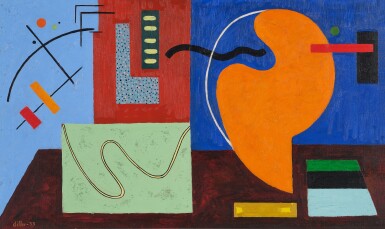Modern Day Auction
Modern Day Auction

Property from a Private Collection, Pennsylvania
Burgoyne Diller
Early Geometric (Abstraction)
Auction Closed
May 16, 09:00 PM GMT
Estimate
80,000 - 120,000 USD
Lot Details
Description
Property from a Private Collection, Pennsylvania
Burgoyne Diller
1906 - 1965
Early Geometric (Abstraction)
signed diller and dated 33 (lower left)
oil on canvas
24 by 40 ¼ in.
63.5 by 104.1 cm.
Executed in 1933.
Meredith Long & Company, Houston (acquired by 1990)
J. Donald Nichols, Nashville (acquired by 1998)
Gary Snyder Fine Art, New York
Utilities & Industries Management Corporation (acquired from the above in 2000)
[with] Salander O’Reilly Gallery, New York (acquired in 2005)
Menconi & Schoelkopf Fine Art, New York
Acquired from the above in 2011 by the present owner
Exh. Cat., New York, Whitney Museum of American Art, Burgoyne Diller, September - November 1990, no. 26, p. 27, illustrated
Washington, D.C., The Phillips Collection; Ohio, Dayton Art Institute; Chicago, Terra Museum of American Art and Fort Worth, Amon Carter Museum, Theme and Improvision: Kandinsky & The American Avant Garde, September 1992 - August 1993, no. 13, pp. 141, 180 and 224
Winston-Salem, North Carolina, Wake Forest University, American Abstract Art of the 1930s and 1940s, The J. Donald Nichols Collection, August - October, 1998, p. 45, illustrated in color
A pioneering American modernist, Burgoyne Diller devoted his career to geometric abstraction. Diller was a lifelong advocate for the avant-garde, ranging from his initial interest in Cézanne to his late-career commitment to the De Stijl movement. Diller painted Early Geometric in 1933, marking a turning point in his oeuvre–the piece, a visionary early work, blends cubism with biomorphic forms. The canvas is dominated by rectangles, but he softens this angularity with whip-like lines and dots clearly influenced by Kandinsky, who Diller admired. A shrewd application of paint enlivens the forms, ranging from plaster-like in the pale green rectangle to a thin, dry wash at lower left.
While Diller would later flatten his surfaces, Early Geometric has an illusion of depth due to its receding planes. The forms inhabit a stage-like arena, taking on personality to become the protagonists of Diller’s scene. Through this compositional precision, Diller “instills his simplified geometric compositions with emotion, spirituality, and a sense of the heroic” (Michael Rosenfeld, “Burgoyne Diller and the Third Dimension,” Burgoyne Diller: The Third Dimension: Sculpture and Drawings. 1930-1965, New York, 1997, n.p.).
You May Also Like








